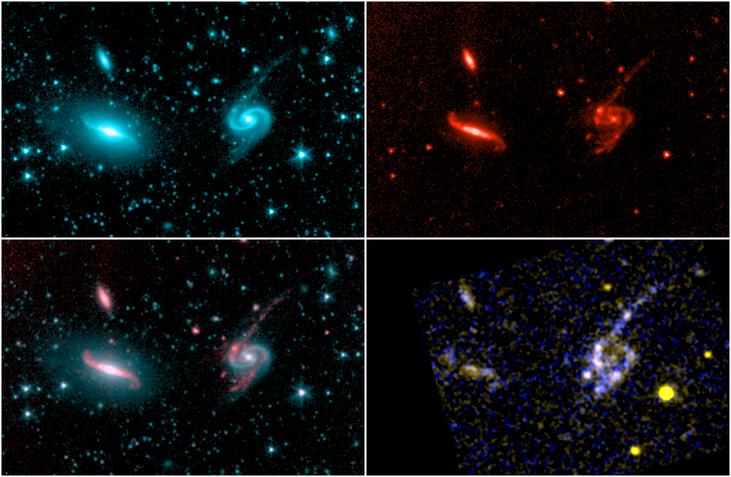
Click here for larger jpg image.
Click here for larger tif image.
High resolution images from NASA's Spitzer infrared telescope and GALEX ultraviolet telescope show the difference in the distribution of young and old stars in the Arp 65 pair of interacting galaxies. In the short-wavelength infrared at 3.6 microns (first image), cool old stars are bright, so the beautiful grand design spiral patterns in the old stellar disks are visible. In contrast, at longer infrared wavelengths, at 8 microns, bright clumps of young stars are detected (second image). The difference in distribution between the old and young stellar populations is clear in the third image, where the 3.6 micron (blue) and 8.0 micron (red) images are combined. This clumpy structure is also present in the ultraviolet, as revealed in the GALEX ultraviolet images (fourth image, with near-ultraviolet in yellow and far-ultraviolet in blue).
These images were presented at the American Astronomical Society meeting in Minneapolis, Minnesota, on May 30, 2005.
Contact: Mark Giroux, East Tennessee State University, Department of Physics, Astronomy, and Geology, (423) 439-8684, girouxm@etsu.edu
PHOTO CREDIT: NASA/JPL-Caltech/M. L. Giroux, B. J. Smith, C. Struck, P. N. Appleton, V. Charmandaris and W. Reach.
NASA's Jet Propulsion Laboratory, Pasadena, Calif., manages the Spitzer Space Telescope mission for NASA's Science Mission Directorate, Washington, D.C. Science operations are conducted at the Spitzer Science Center, California Institute of Technology, Pasadena, Calif. JPL is a division of Caltech.
GALEX (Galaxy Evolution Explorer) is a NASA Small Explorer. It was developed and built by Chris Martin and his team at Caltech/JPL, in collaboration with the Centre National d'Etudes Spatiales of France and the Korean Ministry of Science and Technology. These observations were obtained as part of the GALEX Guest Observer program.